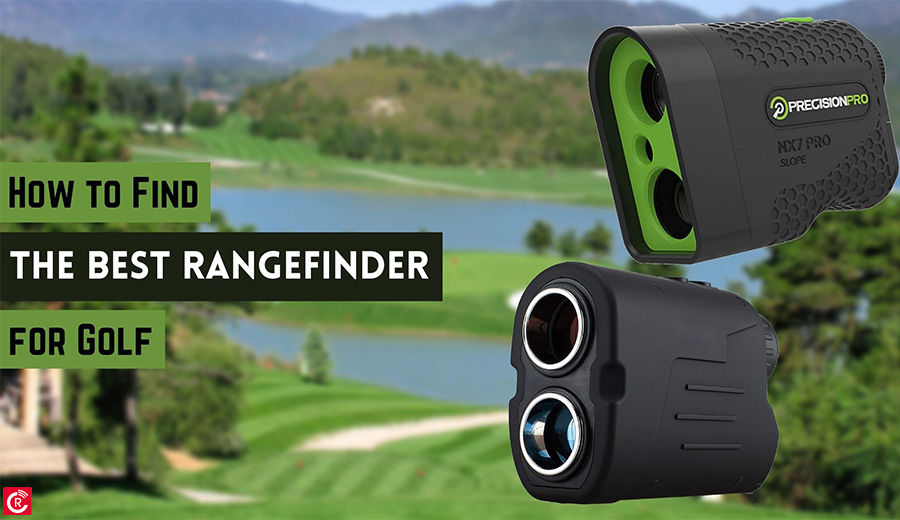
Golf is a sport that requires patience, accuracy, and precision. While humans are still limited with their capabilities, technology has proceeded much further. With the help of Rangefinders now, you can plan your shot with much more accuracy. However, getting the perfect rangefinder is essential, which is precisely what this article talks about. Check out these points to know what you should look for in a rangefinder. Stick to the end, and we got the top 5 best rangefinders in the market as well. Let’s go swinging!
What Are Golf Rangefinders?
First, let’s address the elephant in the room. What exactly is a rangefinder? Well, to put it simply, golf rangefinders are a type of binoculars specially designed for golfers to get a better idea of the distance and accuracy of their shot. This estimate would let you know how hard the ball should be hit to make a great shot.
How to Find the Best Golf Rangefinder?
Accuracy
The most crucial aspect to consider before purchasing a rangefinder is to check its accuracy. It is understandable that if the device is inaccurate, you would be more harmful than beneficial to your game. No rangefinder is 100% accurate, but we need the closest one. Companies do put up a claim that they are accurate to up to 1 yard. However, you need to test it, to know it. If you think you have made a wrong purchase, return it. Wrong measuring would instead degrade your game rather than improve it.
Slope Reading
A plus point that not all rangefinders have or even need. It is a feature considered an add-on, but we genuinely feel it should be a part of your rangefinder for the cherry on top. In addition, your rangefinder should be able to measure variations in the elevation from the player to the target. This would give you more info about the field you are shooting in and take better shots that are much more precise. Note: Slope readers are not allowed in professional golfing, so make sure you do not depend on it if you play professionally.
Display Screen
Now, this is a feature that varies from device to device. It ultimately depends upon your preference. As the rangefinders come with display screens, you need one that is easily readable to you, and you do not have to strain your eyes. Some screens display the digits in bright red, which is quite popular since they are the easiest to read. But that makes them pricey as well. There are others, too, so you should check out multiple rangefinders before finalizing one. Get a rangefinder that has a clear display with punchy digits. It should have data like the distance, the battery percentage, and the crosshair in its interface.
Level of Magnification
Mostly ignored but a feature that makes a significant difference in the run. This has a great impact on the success of your shots. Magnification simply means zooming in. A rangefinder should have a good magnification or zooming capability to give the player a better view. As a result, the shot can be even more accurate to the target. Some laser rangefinders go from 0 to 7X magnification also. Mostly, 6X is all you get from most devices.
Battery Life
Any gadget you use should last long on its battery so that you don’t have to go around charging it. The same goes for golf rangefinders. You need a rangefinder with longer battery life since golf is a slow game, and you spend hours on the ground with probably no plug point nearby. Of course, you can use power banks, but that is another hassle. Every model is different and has different battery power and consumption levels. Most decent rangefinders can go to 8 hours on a single charge, while some can even take 10 hours. Pick the one you think fits your requirements and has a good battery backup too.
Stabilization
It shouldn’t be surprising that we are still figuring out magnifying technology on smaller objects. This is why often you would notice a large shake when you zoom into things. This might seem nothing from your eyes because there are no completely stable hands, but the more you zoom in, the shakier it gets. This is why you need to see the magnifying capacity and how the stabilization works in the rangefinder. 7X zoom with no stabilization is useless since nothing clear would be visible. Stabilization would connect the laser to the target and sustain that angle. Whereas some rangefinders have scan mode, which continuously tracks the target and connects to it. Both resolve shakiness, but you need to see which suits you in this case.
Dimensions
Size and weight are essential for a rangefinder since they need to be small and light. Heavy rangefinder would degrade stabilization since you would have a problem holding it for long. Go for a wide model if you can, which mimics a binocular, and the use of two hands would give you better stability too. The rangefinder should be compact in any case yet loaded with the required features.
Minimum and Maximum Range
Not an essential, again, but a feature of great use. Devices showing measurements around the target make you more aware of the area and deliver a great shot accordingly. This is why minimum range and maximum range can be of help. We strongly recommend that you consider it.
Interface
The golf rangefinder displays some crucial data and sometimes a lot of it. This is why the UI needs to be smooth and easy to understand. Quick measurements and simplicity is the key here. A complicated user interface would suck out all the fun from the sport and rather frustrate you.
Different “PRIORITIES”
Every rangefinder comes with a set of priorities. This is the mechanism through which they detect and lock onto the target. For example, some devices lock the foreground objects first, and therefore they are called “first priority” golf rangefinders. Many others simply focus on the background and lock it first, making them the “second priority” rangefinders.
- The first priority mode might seem like the best option, but they also have restrictions. For example, if you play in a field with a lot of objects such as trees, you won’t get a satisfactory result. But, on the other hand, if it is plainer and only the target is clearly visible, they indeed come in hand.
- Second Priority mode is not bad at all but serves a greater purpose in other ways. For example, it can pierce through trees and objects since it focuses on the background first. Great help, especially for hunters.
Pick the one that suits you. There are rangefinders with both modes, but they are for advanced golfers and are pretty expensive.
Build Quality
The gold rangefinder needs to be built with an excellent quality material which makes it long-lasting, solid, and sturdy. Cheap plastic used in its making would eventually get it broken before you even know it. Get the ones with more robust build quality so that you use them for the longest time. Matt finishing on the outside is a plus point.
Price
Yes. We know. You have been waiting for this. The price is the most crucial factor when getting a rangefinder. Still, it shouldn’t distract you from getting the one with the features mentioned above. Do not opt for cheaper alternatives. Get a good-quality gold rangefinder that will cost you around $100 to $150. Premium quality rangefinders are also recommended that cost anything above $200, but only when you are seriously into the sport and want to invest your money in it.
This was it. Make sure you tick this checklist when you purchase a rangefinder for yourself. Before we wrap up, here are our top picks for the best rangefinders in the market:
- Garmin Approach Z80
- Nikon Coolshot Pro Stabilized
- Bushnell Pro XE
- Bushnell Tour V5 Shift Slim Edition
- Zoom Focus Tour
Conclusion
Rangefinders are great tools that would drastically improve your game. You just need to find the right one for yourself. So make sure to check this list out anytime you miss out on any feature. Wishing you all the very best. “Hit ‘Em long and straight!”





